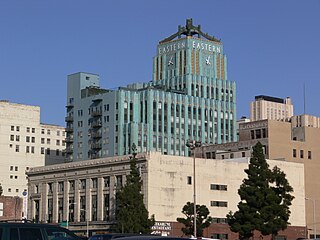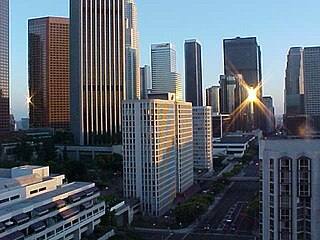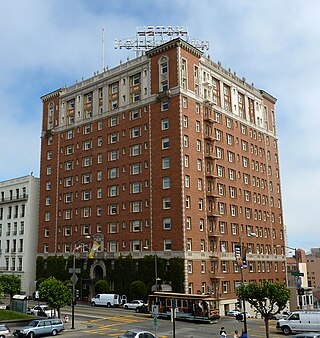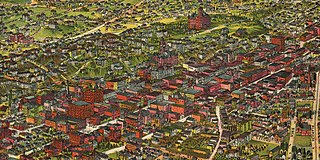
Downtown Los Angeles (DTLA) is the central business district of the city of Los Angeles. It is part of the Central Los Angeles region and covers a 5.84 sq mi (15.1 km2) area. As of 2020, it contains over 500,000 jobs and has a population of roughly 85,000 residents, with an estimated daytime population of over 200,000 people prior to the COVID-19 pandemic.

The Historic Core is a district within Downtown Los Angeles that includes the world's largest concentration of movie palaces, former large department stores, and office towers, all built chiefly between 1907 and 1931. Within it lie the Broadway Theater District and the Spring Street historic financial district, and in its west it overlaps with the Jewelry District and in its east with Skid Row.

Broadway, until 1890 Fort Street, is a major thoroughfare in Los Angeles County, California, United States. The portion of Broadway from 3rd to 9th streets, in the Historic Core of Downtown Los Angeles, was the city's main commercial street from the 1910s until World War II, and is the location of the Broadway Theater and Commercial District, the first and largest historic theater district listed on the National Register of Historic Places (NRHP). With twelve movie palaces located along a six-block stretch, it is the only large concentration of movie palaces left in the United States.

The Homer Laughlin Building, at 317 South Broadway in downtown Los Angeles, is a landmark building best known for its ground floor tenant the Grand Central Market, the city's largest and oldest public market that sees 2 million visitors a year.

The Financial District is the central business district of Los Angeles It is bounded by the Harbor Freeway to the west, First Street to the north, Main and Hill Streets to the east, and Olympic Boulevard and 9th Street to the south. It is south of the Bunker Hill district, west of the Historic Core, north of South Park and east of the Harbor Freeway and Central City West. Like Bunker Hill, the Financial District is home to corporate office skyscrapers, hotels and related services as well as banks, law firms, and real estate companies. However, unlike Bunker Hill which was razed and now consists of buildings constructed since the 1960s, it also contains large buildings from the early 20th century, particularly along Seventh Street, once the city's upscale shopping street; the area also includes the 7th and Flower area at the center of the regional Metro rail system, restaurants, bars, and two urban malls.

The Million Dollar Theatre at 307 S. Broadway in Downtown Los Angeles is one of the first movie palaces built in the United States. It opened in 1917 with the premiere of William S. Hart's The Silent Man. It's the northernmost of the collection of historical movie palaces in the Broadway Theater District and stands directly across from the landmark Bradbury Building. The theater is listed in the National Register of Historic Places.

The Eastern Columbia Building, also known as the Eastern Columbia Lofts, is a thirteen-story Art Deco building designed by Claud Beelman located at 849 S. Broadway in the Broadway Theater District of Downtown Los Angeles. It opened on September 12, 1930, after just nine months of construction. It was built at a cost of $1.25 million as the new headquarters and 39th store for the Eastern-Columbia Department Store, whose component Eastern and Columbia stores were founded by Adolph Sieroty and family. At the time of construction, the City of Los Angeles enforced a height limit of 150 feet (46 m), however the decorative clock tower was granted an exemption, allowing the clock a total height of 264 feet (80 m). J. V. McNeil Company was the general contractor.
Claud W. Beelman, sometimes known as Claude Beelman, was an American architect who designed many examples of Beaux-Arts, Art Deco, and Streamline Moderne style buildings. Many of his buildings are listed on the National Register of Historic Places.

Paramount Theatre, formerly Metropolitan Theater or Grauman's Metropolitan Theater, also known as Paramount Downtown, was a movie palace and office building located at 323 W. 6th Street and 536 S. Hill Street, across the street from Pershing Square, in the historic core of downtown Los Angeles. It had an additional entrance connecting it to the Broadway Theater District and it was the largest movie theater in Los Angeles for many years.

Gas Company Tower is a 52-story, 749 ft (228.3 m) class-A office skyscraper on Bunker Hill in downtown Los Angeles, California. Located on the north side of Fifth Street between Grand Avenue and Olive Street, across from the Biltmore Hotel, the building serves as the headquarters for the Southern California Gas Company, which vacated its previous offices on Eighth- and Flower-streets in 1991, and is home to the Los Angeles offices of law firm Arent Fox.

The Broadway Theater District in the Historic Core of Downtown Los Angeles is the first and largest historic theater district listed on the National Register of Historic Places (NRHP). With twelve movie palaces located along a six-block stretch of Broadway, it is the only large concentration of movie palaces left in the United States. The same six-block stretch of Broadway, and an adjacent section of Seventh Street, was also the city's retail hub for the first half of the twentieth century, lined with large and small department stores and specialty stores.

Weeks and Day was an American architectural firm founded in 1916 by architect Charles Peter Weeks (1870–1928) and engineer William Peyton Day (1886–1966).

The Provident Loan Society of New York is a not-for-profit organization headquartered at 346 Park Avenue South on the corner of 25th Street in the Rose Hill neighborhood of Manhattan, New York City. It was created in the 19th century by a group of influential New Yorkers as an alternative to the loan sharks of the day. Founders include Robert W. De Forest, James Speyer, Otto T. Bannard, J. P. Morgan, Jacob H. Schiff, August Belmont, Jr. and Cornelius Vanderbilt II.

Society for the Preservation of Downtown Los Angeles, also known as SP-DTLA, is a 501(c)(3) organization that advocates what it characterizes as responsible and respectful development around and among Downtown Los Angeles' historic structures. SP-DTLA supports development with a positive impact on the designated Los Angeles Historic-Cultural Monuments in Downtown Los Angeles, especially those in the Historic Core.

The Bloc, formerly Macy's Plaza and Broadway Plaza, is an open-air shopping center in downtown Los Angeles at 700 South Flower Street, in the Financial District. Its tenants include the downtown Los Angeles Macy's store, LA Fitness, Nordstrom Local, UNIQLO, and the Sheraton Grand Los Angeles hotel. The shopping center has its own entrance to the 7th Street/Metro Center station of the Los Angeles Metro Rail system. The Bloc tends to connect the financial, fashion, jewelry, and theater districts and the 7th Street Metro Center Station, meaning where four Downtown Los Angeles lines converge more.

The State Theatre, formerly Loew's State Theatre, at 703 S. Broadway, is a movie theatre that opened in November 1921 in what is now the Jewelry District and Broadway Theatre District in the historic core of Downtown Los Angeles.

The late-Victorian-era Downtown of Los Angeles in 1880 was centered at the southern end of the Los Angeles Plaza area, and over the next two decades, it extended south and west along Main Street, Spring Street, and Broadway towards Third Street. Most of the 19th-century buildings no longer exist, surviving only in the Plaza area or south of Second Street. The rest were demolished to make way for the Civic Center district with City Hall, numerous courthouses, and other municipal, county, state and federal buildings, and Times Mirror Square. This article covers that area, between the Plaza, 3rd St., Los Angeles St., and Broadway, during the period 1880 through the period of demolition (1920s–1950s).

Ville de Paris was a department store in Downtown Los Angeles from 1893 through 1919.

7th Street is a street in Los Angeles, California running from S. Norton Ave in Mid-Wilshire through Downtown Los Angeles. It goes all the way to the eastern city limits at Indiana Ave., and the border between Boyle Heights, Los Angeles and East Los Angeles.

Bullock's complex is a collection of nine historic buildings located at 639-651 south Broadway, the 300-block of 7th Street, and 634-670 south Hill Street in the Jewelry District and Broadway Theater District in the historic core of downtown Los Angeles. Each building is a contributing property in the National Register of Historic Places-listed Broadway Theater and Commercial District, five buildings are contributing properties in the City of Los Angeles-recognized Hill Street Commercial Historic District, and four buildings are contributing properties in the City of Los Angeles-recognized Seventh Street Commercial Historic District.




















